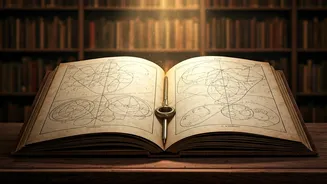Ancient Mathematical Roots
India's contributions to mathematics are vast and have roots that stretch back thousands of years. The NCERT's Class 7 Maths textbook will delve into this
history, showcasing the groundbreaking work done by Indian mathematicians. These pioneers explored concepts in algebra and geometry, laying the groundwork for many of the mathematical principles that students learn today. They developed innovative techniques, discovered fundamental theorems, and made significant progress in areas such as arithmetic, trigonometry, and calculus. Their work, often centuries ahead of its time, not only advanced mathematical knowledge but also influenced civilizations across the globe. This revised textbook aims to present this rich legacy, offering students a comprehensive understanding of India's role in the development of modern mathematics.
Algebraic Contributions
Algebra, which has become a fundamental tool in mathematics, owes a great deal to ancient Indian scholars. The new NCERT textbook will spotlight specific contributions, such as the introduction of the decimal system, which revolutionized numerical operations, and the concept of zero, a groundbreaking invention that significantly simplified mathematical calculations. The book will likely explore the use of symbols and equations, including quadratic equations. Indian mathematicians also explored advanced algebraic concepts, developing methods for solving various types of equations and simplifying complex expressions. Their innovative approach to algebra was not only vital for the advancement of mathematical knowledge, but it also made a huge impact on fields such as astronomy, architecture, and commerce, demonstrating the versatility and importance of these mathematical techniques.
Geometrical Discoveries
Geometry, with its focus on shapes, space, and measurement, was also significantly advanced by Indian mathematicians. The NCERT Class 7 Maths textbook will highlight key geometrical discoveries made in ancient India. It will cover the works on concepts such as the Pythagorean theorem, area calculations, and the exploration of different geometric figures. Indian mathematicians developed methods for calculating the areas and volumes of complex shapes, leading to the development of construction techniques and engineering principles. The knowledge gained from geometry was not just limited to theoretical understanding; it had an impact on practical applications, like the design of temples, construction of buildings, and astronomical observations, which reflect the remarkable precision of Indian mathematical practices.
Curriculum Enhancement
The updated NCERT textbook is designed not only to teach mathematical concepts but also to build a deeper appreciation of the subject. By including information about India's mathematical contributions, the textbook aims to connect students with their cultural heritage. The goal is to inspire students and demonstrate how mathematical principles have been shaped by the innovative ideas of Indian scholars over the centuries. This approach seeks to provide a more holistic learning experience. Students should find mathematics more engaging and meaningful when they understand its historical and cultural significance. This initiative is an important step towards ensuring that students learn to value their mathematical legacy while understanding the broader global influence.
Future Impact
The introduction of India's mathematical history in the Class 7 Maths textbook has far-reaching effects on the educational landscape. It encourages students to perceive mathematics as a dynamic and evolving field, with a rich past. This understanding can enhance the learning experience, making students more eager to explore mathematical ideas. This approach will also help to build a sense of identity and pride in students, reinforcing their cultural understanding. By introducing historical context, the curriculum is set to encourage creativity, critical thinking, and problem-solving skills, and encourage the next generation of mathematicians to build on India's legacy. This integration helps to ensure a well-rounded and historically informed education for students across the country.











